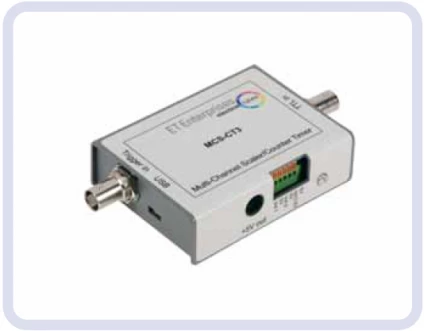Description
The MCS-CT3 is a cost-effective, high-performance pulse counting instrument designed for seamless integration with PCs or laptops via a USB 2.0 interface. This versatile module can be employed as a laboratory rate-meter or transformed into a wide dynamic range photon counting system when paired with an ET Enterprises AD8 amplifier/discriminator and an appropriate detector. Its compact design ensures that it can be easily incorporated into various setups without occupying significant space.
One of the standout features of the MCS-CT3 is its ability to record and store pulses as a function of time, providing users with the flexibility of three software-configurable counting modes: pre-set number of channels, pre-set total measurement period, or continuous measurements. This adaptability allows for precise control over the counting process, which can be managed through the supplied application software or user-customized code. Additionally, the module supports external trigger inputs and offers two trigger outputs for controlling associated hardware, such as optical shutters. At the conclusion of a measurement cycle, results are automatically saved in an MS Excel compatible format, facilitating further analysis or export to other software.
The MCS-CT3 also features a software-controlled analogue voltage output, enabling users to program the high voltage supply to a photomultiplier, such as those in the ET Enterprises series of photomultiplier HVBases. This functionality is particularly useful for generating automatic plateau plots to determine the optimal operating voltage for photon counting applications. To safeguard against photomultiplier overload, a maximum count rate can be set.
MCS-CT3 - Multi-Channel Scaler
Specifications
| Max Count Rate: | 150 MHz |
|---|---|
| Min Pulse Width: | 1.7 ns |
| Interface: | USB 2.0 |
| Count Rate: | up to 150 MHz |
| Input: | TTL |
| Channel Widths: | 200µs to 999hr |
| Number Of Channels: | 1 to 65535, or continuous operation |
Features
- High Performance Pulse Counting: The MCS-CT3 is a cost-effective, high-performance pulse counting instrument for use with a PC or Laptop via the USB 2.0 interface.
- Versatile Operating Modes: Offers three software-configurable counting modes: pre-set number of channels, pre-set total measurement period, or continuous measurements.
- Easy Data Management: Operation and data retrieval can be controlled from the supplied application software or from users’ own customized code, with results automatically saved to an MS Excel compatible file.
- External Triggering: Includes a trigger input for measurement control and two trigger outputs for associated hardware control.
- Analogue Voltage Output: Features a software-controlled analogue voltage output for programming high voltage supplies, enabling automatic plateau plots for optimal photon counting operation.
- Software Applications: Comes with 'MCS-CT3 Control' and 'MCS-CT3 Excel Control', both easy to install and customize without ActiveX controls.
- USB Powered: Power is supplied via the PC USB 2.0 connection, eliminating the need for an additional power supply.
Applications
- Photon Counting Systems - Ideal for use in wide dynamic range photon counting systems when paired with an ET Enterprises AD8 amplifier/discriminator and suitable detector.
- Laboratory Rate-Meter - Can be easily configured for laboratory use as a rate-meter to count and store pulses over time.
- Time-Resolved Single Photon Counting - Particularly suitable for time-resolved single photon counting mode operation, especially when used with TTL output AD8 amplifier/discriminator.
- TTL Pulse Counting - Suitable for applications involving counting, storage, and processing of TTL pulses as a function of time.
Frequently Asked Questions
What is the MCS-CT3?
What are the features of the MCS-CT3?
What applications is the MCS-CT3 suitable for?
What operating modes does the MCS-CT3 have?
What additional equipment is required to use the MCS-CT3 as a photon counting system?
Your inquiry has been received.
Create an account by adding a password
Why create an account?
- Auto-complete inquiry forms
- View and manage all your past messages
- Save products to your favorites
- Close your account anytime — no hassle
